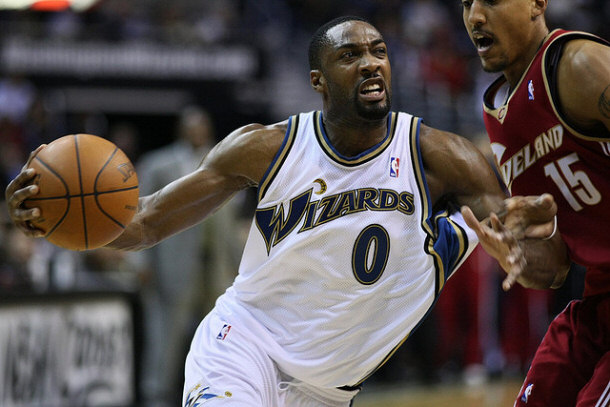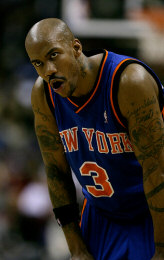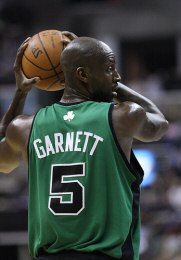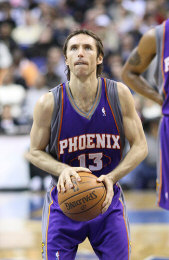Aging in the NBA
Introduction
With the retirement of Jason Kidd (1994 – 2013) and Grant Hill (1994 – 2013) at
the end of the 2012 – 2013 National Basketball Association (NBA) season,
spectators saw not just the end of two phenomenal careers, but a fitting
conclusion for two of the greatest players of all time – as they left the game
on their own terms.
Retiring at the age of 40, what is perhaps most remarkable for Kidd and
Hill is that both left behind a legacy that never saw their respective
talents significantly wane with age. Kidd never lost his passing ability,
court vision and basketball IQ that made him one of the greatest
point-guards of all time. While Hill's career was indeed hindered by injury
over the years, it never marred other factors that he had to offer to the
league, such as character, personal strength and leadership.
This is why age and aging is a curious thing in the NBA. In a league with no
shortage of young athletic talent, the reality is that older players still have
their place in the league – even if it’s one that younger, up-and-coming players
are eager and always willing to usurp or at least try to.
Like many other sports, age is generally not an asset in the NBA. When the
youthful athleticism fades from a player’s game, their career is soon sure to
follow. It’s only in a few rare cases that players can manage to overcome the
wear and tear of time and continue to produce and contribute at a high level for
their team.
It’s a rare combination of talent, dedication, luck and personal strength
that sees such rarities as Kidd and Hill succeed against the odds and, more
importantly, the inevitable ravages of age.
Casualties of Age
Over years the NBA has seen a number of good to phenomenally great players
felled by age. No sooner had they arrived than they were announcing their
retirement or being forced out of the league due to their inability to
significantly contribute – pushed aside in favor of younger players with
potential on their side.
Once nicknamed “Stevie Franchise” given his tremendous talent and
phenomenal athleticism, Steve Francis (1999 – 2008), went from being a household
name amongst sports fans for his consistent highlight real-maker plays to
struggling for a game in a matter of just a few years. By his early 30s, he was
no longer capable of competing in the NBA nor even overseas, where the
competition is significantly less intense than in comparison to the NBA.
Gilbert Arenas was another whose career took a sudden and unexpected turn. It
was only shortly after signing a multi-year, multi-million dollar contract worth
well over $100 million that his career faded into obscurity. Upon signing the
contract, he was expected to lead his up-and-coming team, the Washington
Wizards, to the top of the league, bringing a legitimate challenge for the
championship.
This objective, however, was put on hold (then later abandoned all together)
when Arenas was suspended for a season. Ultimately, upon reflection, the
phenomenal contract was one of the worst decisions in the history of the
Washington franchise – a franchise with no shortage of horrible decisions to its
name, such as wasting the number one pick in the 2001 NBA Draft on a player
like, Kwame Brown (2001 – present), a player whose talent was as questionable as
his character.

After a year-long suspension, Arenas (now in his late 20s) returned a year
older, maybe a little wiser, but no longer the star player he had once been.
Once known as a franchise player – one that could be counted on to lead the team with
his athletic talent, competitive nature and innate leadership qualities – seemed
to have lost a little bit of everything that had once made him great and the key
to Washington’s success.
The year off shouldn’t have had any real impact on Arenas’ game, as Arenas
had come back in good health, but the year away from the league was the
beginning of the end. Arenas was later traded to the Orlando Magic, where he was
soon waived. After a brief stint with the Memphis Grizzlies, Arenas’ career in
the NBA was at an end by his early 30s.
Arguably one of the most unfortunate careers that was hindered by age was
Tracey McGrady (1997 – present). Entering the league straight out of high
school, McGrady’s arrival into the NBA, though short on playing time, was met
with much speculation and excitement over his natural athleticism and talent,
but moreover because of his potential.
While McGrady’s first few years were the source of much personal frustration
with the Toronto Raptors, as he was forced to sit on the bench and watch his
team mates, it was just a matter of time before he’d make his mark in the
league. Following in the footsteps of the greatest NBA player off all time,
Michael Jordan (1984 – 2003), McGrady would win multiple scoring-titles in the
league.
Amongst many other great performances throughout his career, was one
particularly phenomenal game against the San Antonio Spurs. With his team down
and facing certain defeat, McGrady scored an incredible 13 points in 35 seconds
to secure the win, making for one of the greatest scoring performances in league
history. However, despite such performances and managing to remain in the
league, even now in his mid 30s, he’s no longer the star player he once was, as
injury has ultimately colluded with age to all but end the career of one of the
greatest player’s in recent years.
Age and Immaturity
Age and maturity don’t necessarily go hand-in-hand. While the ravages of age
have claimed many players’ careers, sometimes the players and their petulance
are squarely to blame.
Allen Iverson (1996 – 2010) was at one time a force in the league. In 2001,
beyond winning the league MVP, he also led his team, the Philadelphia 76ers, to
the NBA finals up against the Los Angeles Lakers, with their dominating duo of
Shaquille O’Neal (1992 – 2011) and Kobe Bryant (1996 – present). Despite losing
in a best of seven games series, Iverson led his team to a historic game one
victory on the Lakers’ home court.
Remarkably, despite his reputation for an aversion to practice, Iverson
managed to retain much of his athleticism and talent as he aged. However, his
personality and ego conspired against him to secure an unfortunate and senseless
end to his NBA career. He refused to accept anything less than a starring role
on a team, thereby making it unappealing for any team to consider signing him.
Even teams that were struggling opted to steer clear of Iverson. Despite his
talent, the drawbacks of having to deal with his personality and lack of
maturity still greatly outweighed any and all positives that he might bring to
any team.
Stephon Marbury (1996 – 2009) also sullied his legacy with his petulance.
He’d always been a star player from high school, through to college and even
from the second that he entered the NBA. Naively, he had always expected to be a
star play.
Growing up in New York City, Marbury’s dream was to play for the city’s team,
the Knicks. After bouncing around the league, he finally landed in his dream
destination with his dream team. The dream would soon become a nightmare, though
– inexplicably, it was Marbury himself who made sure of it.
 As he entered his 30s, Marbury was still at least a decent player, even if he
wasn’t the star he had always been. The Knicks franchise was struggling and
eager to rebuild with younger players. Once it was clear to Marbury that he was
no longer going to be a starting point guard, he wasn’t happy. Given his history
as one of the best point guards in the league, team officials had wanted him to
remain with the team and serve as a mentor to the younger players. Marbury had
other ideas. He still wanted to play – either that or he wanted his contract
bought out. For all that it was worth. As he entered his 30s, Marbury was still at least a decent player, even if he
wasn’t the star he had always been. The Knicks franchise was struggling and
eager to rebuild with younger players. Once it was clear to Marbury that he was
no longer going to be a starting point guard, he wasn’t happy. Given his history
as one of the best point guards in the league, team officials had wanted him to
remain with the team and serve as a mentor to the younger players. Marbury had
other ideas. He still wanted to play – either that or he wanted his contract
bought out. For all that it was worth.
While the team indeed offered to buyout Marbury’s contract, which was worth
more than $20 million, he wanted ALL the money, not just a portion of it, which
is customary for contract buyouts. Ultimately, the saga dragged on for months –
within the organization, on the court and in the media.
Marbury was finally released just before the trade deadline, which meant that
he was free to join another club. He chose to finish out the season with the
defending champions, the Boston Celtics. While the team had a good run at
another championship that year, they fell short to the Los Angeles Lakers.
Unable to play a starring role on the team, Marbury opted to give up on the NBA
and play overseas, where his talent was still at a high enough level to secure
him a starting role on a team.
Exploring opportunities overseas, where they can get more playing time, is
something many older NBA players do when their playing time wanes in the league.
Much like in Marbury’s and Iverson’s cases, this usually happens, not
necessarily because of a lack of talent but, rather, a serious lack of
self-awareness, professionalism and perhaps more importantly maturity.
Consistent Evolution
It’s inevitable that as a player ages, they’ll lose their athleticism, no
longer being the player they once were and will no longer be able to contribute as they
once had. Often this signals the end of their career. While that has been the
case for a number of players, others have managed to overcome the seemingly
inevitable. Many players who were once dominant manage to alter their game and
playing style to a point where what was once their weaknesses are now their
strengths.
Initially just noted for his athleticism and scoring ability, Michael Jordan
took the early criticism and suggestions that he was essentially just a
one-dimensional player, as a motivator to push himself to work on and strengthen
his defensive game. He later won Defensive Player of the Year (DPY) in 1988.
Furthermore, when Jordan was characterized as being a selfish player, he
worked on his passing ability, subsequently getting his teammates involved in
plays, rather than just scoring himself. Jordan would continue his commitment to
improving his game as he aged by adding or adjusting his game constantly.
Always eager to follow in Jordan’s footsteps, Kobe Bryant would look to
Jordan’s work ethic and also alter his game and develop new skills in later
years to compensate for earlier skills that diminished with age.
 As a player, the evolution of Kevin Garnett (1995 – present) also took a
similar path to Jordan. He entered the league right out of high school with an
impressive, though rough game. Despite being packed full of talent and
potential, he was considered a risk when the Minnesota Timberwolves selected him
with the fifth pick in the 1995 NBA Draft. He quickly made his way into the
starting role for the team, before becoming the team’s star player. As a player, the evolution of Kevin Garnett (1995 – present) also took a
similar path to Jordan. He entered the league right out of high school with an
impressive, though rough game. Despite being packed full of talent and
potential, he was considered a risk when the Minnesota Timberwolves selected him
with the fifth pick in the 1995 NBA Draft. He quickly made his way into the
starting role for the team, before becoming the team’s star player.
For a number of years, his intensity and athletic prowess was the spark for
his team – a team not noted for their energy. As he aged and lost some of his
athletic intensity, he put his intensity to another use.
Garnett was traded to the Boston Celtics, a team always known for a
defensive-minded style of play. Though always noted as a strong defensive
presence, Garnett suddenly became the best (or at least the most important)
defensive player in the league, taking DPY honors in 2008.
With clear aspirations to dethrone Jordan as the greatest player of all time,
LeBron James (2003 – present) has also worked tirelessly to improve his game.
Only time will tell if James has the talent to surpass Jordan in regards to
being the best player of all time. Nevertheless, Scottie Pippen (1987 – 2004) a
former teammate of Jordan’s, once described James as perhaps the greatest
athlete (though, not necessarily greatest player) to ever play in the NBA, given
his versatility as both an athlete and as a player, with his ability and
skill-set so intricate that he could play any position adequately if not
perfectly on any given night.
Aging into Superstardom
One of the most curious things about aging in the NBA is that some players don’t
reach their potential until they are in their 30s – a time at which many of
their peers see their careers come to an end. Perhaps the best example of this
is Hakeem Olajuwon (1984 – 2002). He is a two-time, back-to-back Finals MVP and
NBA champion. Although he was a star player from the second he entered the
league in 1984, he never reached his full potential until he was in his 30s.
With the first retirement of Michael Jordan in 1993, the scene was set for
Olajuwon to come out of the shadows and not only prove himself to be the
greatest center in the league, but the best overall player in the league.
Likewise, Steve Nash (1996 – present) one of the greatest point-guards to
ever play the game is another player who didn’t reach his prime until his 30s.
Unlike Olajuwon, Nash’s arrival in the NBA wasn’t seen as significant. Despite
his potential when he was drafted in the 1996 NBA Draft, Nash struggled to make
an impact in the league in his initial years and was traded from the Phoenix
Suns to the Dallas Mavericks.
 It was in Dallas where Nash would be teamed with another player Dirk Nowitzki
(1998 – present), whose own rise to an All Star caliber player correlated Nash’s
own evolution. Together, the two would work on their respective and collective
game, quickly becoming one of the best combinations in the history of the game. It was in Dallas where Nash would be teamed with another player Dirk Nowitzki
(1998 – present), whose own rise to an All Star caliber player correlated Nash’s
own evolution. Together, the two would work on their respective and collective
game, quickly becoming one of the best combinations in the history of the game.
When Nash became a free agent as he entered his 30s, his unique combination
of talent, maturity and leadership skills were of such a high caliber that he
was able to command an expensive, multi-year contract. In the following seasons,
Nash would win back-to-back MVP awards, for his talent and leadership skills.
In 2010, despite being in his mid 30s Nowitzki would sign a massive contract
to stay with Dallas. While some questioned the wisdom of the amount involved,
especially considering Nowitzki’s age, he would show his critics that he was
worth it, when he led his team to an championship against the highly favored,
Miami Heat, with their combination of three much younger superstars, LeBron
James, Dwayne Wade (2003 – present) and Chris Bosh (2003 – present).
From Superstar to Role Player
Many players have trouble at the latter end of their careers, particularly in
regard to admitting to themselves that they are no longer the star players they
used to be. They need to acknowledge that, while they can no longer contribute
like they used to they still have plenty to contribute to a team. In a game
where egos are big and they take longer to fade than does their talent, this
realization is something that players need to make, though few do.
Even while the potential of youth is often favored over experience, veteran
players are still crucial to a team’s success and longevity, regardless of a
veteran player’s time on court (or if they even play at all). In many cases, a
player’s presence and influence on the other, younger players is enough of a
positive impact to justify their position on a team’s roster.
In 2012 and 2013, Juwan Howard (1994 – present), who had once been a star
player – first in Michigan as part of the “Fab Five” and then when he entered
the NBA – played a key role in the Miami Heat’s two championship seasons, due to
his knowledge, maturity and leadership skills – despite barely even playing. His
teammates had often joked that he was more of a coach than a teammate, given his
limited minutes of playing time, coupled with his intangible, invaluable
contributions of experience and leadership to the team.
His impact was similar to other players before him like Moses Malone (1974 –
1995), who went from being a three-time MVP to an intermittently used back-up
player. So too was the case for Dikembe Mutombo (1991 – 2009) one of the
greatest defenders in the history of the league – with four back-to-back DPY.
Over the course of his career, he went from being a starter and the defensive
anchor of a team to being a solid role player and veteran role model for the
younger players on his team.
Even Michael Jordan finished his career as a backup player, moving from a
starting position on the Washington Wizards to become a reserve, when the team’s
coach decided that that would be best for the team.
Conclusion
Nowitzki and the Dallas Maverick’s defeat of the much favored Miami Heat with
their relatively young players – James, Wade and Bosh – epitomized the
importance of age in the NBA. Upon joining forces, the Miami Heat immediately
began talking about dominating the league – before they’d even played a single
game. Unlike each and every championship team before them, they expected the
trophies to be handed to them. Given their youth and talent that rivaled (and in
most cases vastly overshadowed) their competitors, it had appeared that it would
be the case.
It was fitting then that it would come from the least likely source – the
aging and, as many had speculated, over-the-hill Dallas Mavericks with their
aged or rapidly aging core of Dirk Nowitzki, Jason Kidd and Jason Terry, all of
who were in the mid 30s. Though all three were past their respective prime, when
combined with younger talent the team was a collective force.
It was this that was the key to the team’s success – the combination of young
players and veterans, with each bringing something different but equally
important to the team. In a game and a league dominated and sometimes even
obsessed with youth, the 2011 NBA Champion Dallas Mavericks staunchly
illustrated that every player has something to contribute to a team. Sometimes
that’s in spite of age. Other times, though, it’s because of the maturity,
experience, knowledge, leadership or just the intangible that comes only with
age.
Basketball
8 Mediocre Players Who Made It Big (Financially) in the NBA
The Difference Between Streetball and The NBA
Aging in the NBA
Cool Sport Stuff
14 Interesting Facts About Mascots |